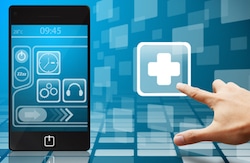The Future of Healthcare Marketing is Already in Your Pocket
 "In a single generation there's been a fundamental shift in the way people interact with personal technology," according to Joseph Swedish, CEO of Wellpoint, Inc. “Smartphone technology, social media and data mining will drive change and shift the future of healthcare.
"In a single generation there's been a fundamental shift in the way people interact with personal technology," according to Joseph Swedish, CEO of Wellpoint, Inc. “Smartphone technology, social media and data mining will drive change and shift the future of healthcare.
Healthcare marketing professionals are increasingly refining their marketing plans, adjusting to how smartphones and mobile devices have dramatically changed the communications channels.
Healthcare and smartphones are already intertwined on several fronts. More than ever, a current marketing plan will envision precision-focus engagement with consumer or provider audience, presenting messages that are precise, direct and immediate.
Mobile technology is transforming the way consumers transact with healthcare, putting the message into their hands…or their pocket.
On the job: nearly all doctors have and use smartphones daily…
“More than 80 percent of physicians across almost all specialties indicated they use a smartphone in their work,” according to a GreenBook survey last year. (And that sounds on the low side to us.)
“Checking email is the most common work-related activity, with primary care physicians and specialists on the move (cardiologists, general surgeons, OB/GYNs and orthopedists) using it most.”
Patients—the consumer public—are connected and engaged…
Smartphone and mobile device owners are health and wellness aware. Among smartphone consumers in the US, according to data from FICO:
- 28 percent look for medical advice on their mobile device at least once per year.
- 11 percent currently receive medical appointment reminders via SMS or a mobile app. (An open-field opportunity for marketing interactions via reminders.)
- 77 percent do NOT receive reminders to take their medications via any channel. (Mobile medication reminders can be a opportunity for improved patient care and reduced costs.)
- 70 percent have owned a mobile for three years or more. (The US is a mature mobile market.)
And worldwide, the global FICO survey says, 80 percent of people would like the option to use their smartphones to interact with health care providers.
This year saw consumer electronics giants enter the wearable-health-tech sector. Most notable among these was the introduction of the Apple iPhone Health app and the announcement of the forthcoming Apple Watch.
It’s important to note that, by definition, consumers of wearable health/wellness devices are health conscious, and that such personal monitors and devices typically require a smartphone link.
For hospital and healthcare marketing, the consumer public has gone mobile; an audience that appears poised to rapidly grow larger and stronger.








